Software licensing solutions are usually associated with desktop or server software applications. Nevertheless, hardware and intelligent device vendors, both in industrial and consumer space, are becoming software vendors too since:
- Hardware is becoming a commodity
- Software has traditionally higher profit margins than hardware
- Accompanying software modules enrich the offered product
- Device vendors require business model flexibility
Consequently, most IoT and intelligent devices contain software modules with permanent or at least sporadic network (http) connectivity. This connectivity is a game changer and the bridge to a professional licensing and usage analytics solution facilitating:
- Feature Enablement: In the majority of cases, vendors want to be capable of easily turning on/off device functionality, eliminating the necessity of physically producing different devices. This facilitates up-selling, which can be even triggered by the end-customer through a dedicated self-service portal. After such a process, the device communicates with the cloud licensing solution in order to fetch the new licensing data and accordingly turn on/off functionality.
- Configuration/Parametrization: Centrally setting and changing parameters controlling the device’s behavior. This is, beyond feature enablement, an additional way to create differentiated solutions and achieve market segmentation.
- Subscription or usage based models: Due to the connectivity with the cloud backend, vendors can capture billing relevant data. For example, a 3D printer vendor can charge a monthly fee or a fee pro printing job or a fee for a volume of printing jobs.
- Analytics/Diagnostics: Beyond monetization and billing, the collected data can be used for analytics, e.g., gaining insights about the actual usage of the device, or for diagnostics, e.g., troubleshooting or predicting component failures.
These are usually very convincing arguments for both business and engineering departments of device vendors.
